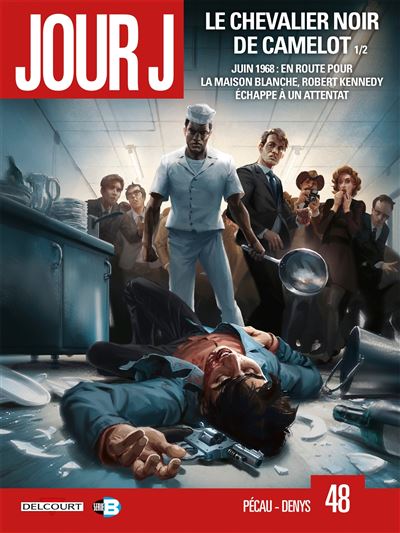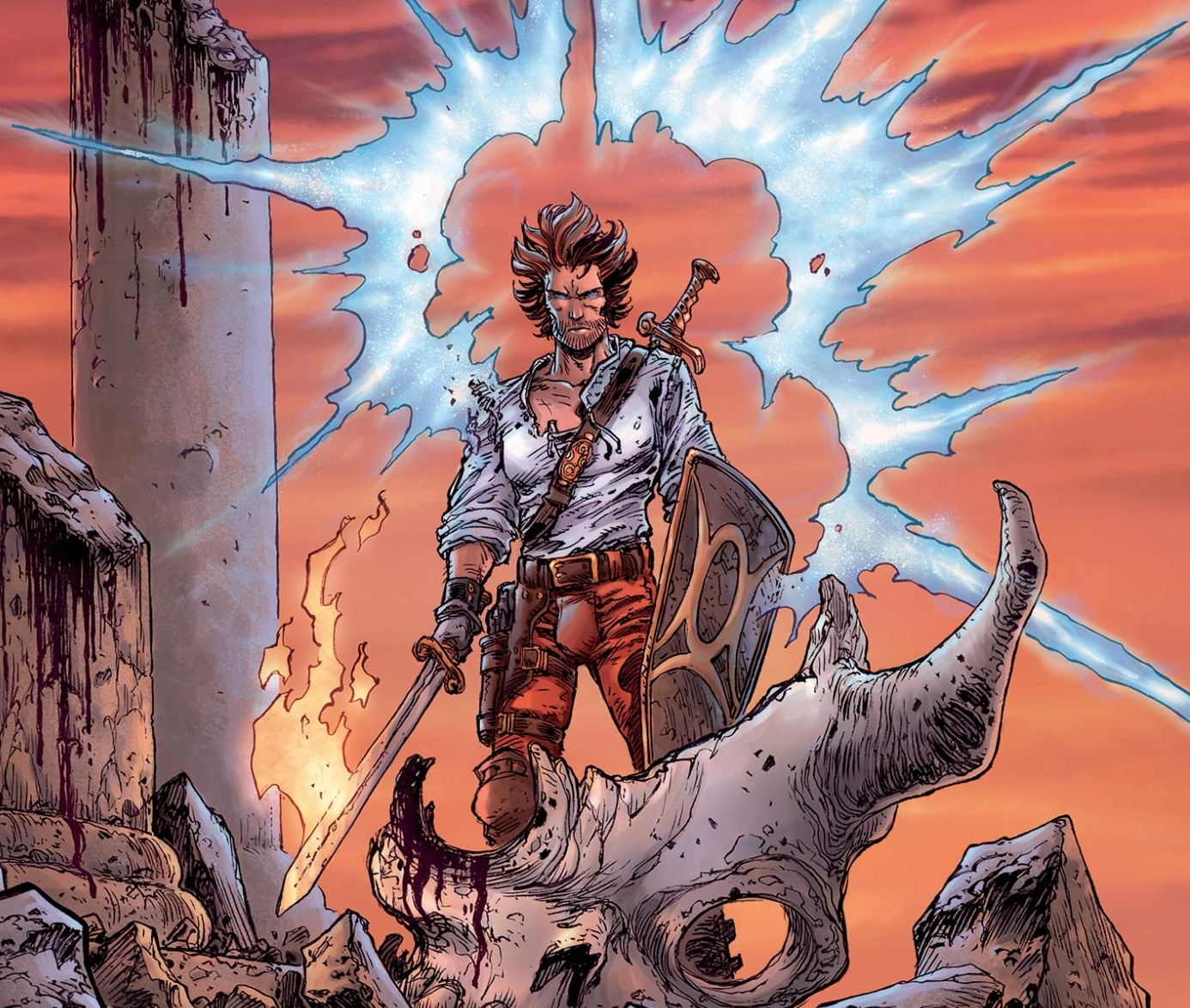Myths have a long life and Astra Saga proves it in this first volume by projecting Norse legends into a science fiction story. Embark with us in search of cursed gold.
Ragnarök and Star Trek
 In the future, a cargo ship flies into space to flee to the army. Indeed, the empire wants to find a crate hidden in its holds. A simple box containing a gold object could profoundly upset the political balance of space if it falls into the wrong hands. Alas, the civilian ship weighs little against the powerful military destroyers and the book opens with the attack of a battalion of soldiers. Through his drawing, Philippe Ogaki manages to embark us with this dragon company. They search the enemy ship but the appearance of an enemy reputed to be legendary will prove to them that the stakes are much higher than a treasure hunt. This gold chest evokes Wagner's The Ring of Nibelungen and the search for Rhine gold and Astra Saga projects you into a post-apocalyptic world because the story is set after Ragnarök, a vast battle between humans and gods. But the stone golems here become robots because Astra Saga comes out of tradition in multiple ways by a personal attempt to give its version of the past. The author, both writer and cartoonist, Philippe Ogaki, started as a decorator in the cartoon. But he is especially passionate about science fiction and finds in comics a way to unleash his creativity. His first comic strip is the adaptation of the novel by Pierre Bordage then he directs the series Azur and Terra Prime.
In the future, a cargo ship flies into space to flee to the army. Indeed, the empire wants to find a crate hidden in its holds. A simple box containing a gold object could profoundly upset the political balance of space if it falls into the wrong hands. Alas, the civilian ship weighs little against the powerful military destroyers and the book opens with the attack of a battalion of soldiers. Through his drawing, Philippe Ogaki manages to embark us with this dragon company. They search the enemy ship but the appearance of an enemy reputed to be legendary will prove to them that the stakes are much higher than a treasure hunt. This gold chest evokes Wagner's The Ring of Nibelungen and the search for Rhine gold and Astra Saga projects you into a post-apocalyptic world because the story is set after Ragnarök, a vast battle between humans and gods. But the stone golems here become robots because Astra Saga comes out of tradition in multiple ways by a personal attempt to give its version of the past. The author, both writer and cartoonist, Philippe Ogaki, started as a decorator in the cartoon. But he is especially passionate about science fiction and finds in comics a way to unleash his creativity. His first comic strip is the adaptation of the novel by Pierre Bordage then he directs the series Azur and Terra Prime.
Games of thrones and Star Wars
 Astra Saga is not only a series of fights but the reader also finds himself in the middle of court intrigues with multiple characters evoking Game of Thrones. The coalition of baronies rejected the imperial yoke to defend freedom, but only one family opted for support for the emperor in the name of political security. This paternal choice repels the son of the baron who wants to join the revolt. His very young sister proved to be the most far-sighted. Indeed, the second part, easier to understand, follows mainly two characters, two children in the middle of the war: this princess far too intelligent for her age and the military apprenticeship of a soldier in the past. In the middle of the book, we follow in a flashback the past of a blue-skinned soldier, Sey. Starting as a thief on the docks, he becomes a soldier loyal to the emperor because the army allows him to escape his sad condition. This part of the scenario shows that Astra Saga offers an extremely dense universe. Beyond Norse mythology, Philippe Ogaki mixes science fiction withnineteenth-century novels. The soldiers' uniforms and sets came out of War and Peace. Tolstoy's seemingly written dialogues describe the social inequality between poor people whose only way out is to become the cannon fodder of empire and the aristocracy living in idleness even if marriage is for them only a contract to strengthen influence and expand the territory of a clan. These different themes merge into a dense drawing also made by Philippe Ogaki. The scenery is splendid. If the whole is in the Franco-Belgian tradition of epic science fiction, some faces are reminiscent of manga. The publisher Delcourt offers a luxurious setting to this new series by the superb cover with a very complex gilding. Asta Saga is also much more than a book by offering a real encyclopedia by augmented reality. The reader, however, can be lost at the beginning of the story in the middle of all these proper names and among the teeming details of the drawing. It would have been useful to have a sharper inking to help the reader find his way around and to ventilate the story so that the reader can more easily project himself. If you are tired of easy and quick reading, we advise you to open Astra Saga by Philippe Ogaki. This unique first volume launches a wide saga combining multiple influences to offer his own vision of science fiction. You can find other columns on recent science fiction titles with Amen and Bettie Hunter.
Astra Saga is not only a series of fights but the reader also finds himself in the middle of court intrigues with multiple characters evoking Game of Thrones. The coalition of baronies rejected the imperial yoke to defend freedom, but only one family opted for support for the emperor in the name of political security. This paternal choice repels the son of the baron who wants to join the revolt. His very young sister proved to be the most far-sighted. Indeed, the second part, easier to understand, follows mainly two characters, two children in the middle of the war: this princess far too intelligent for her age and the military apprenticeship of a soldier in the past. In the middle of the book, we follow in a flashback the past of a blue-skinned soldier, Sey. Starting as a thief on the docks, he becomes a soldier loyal to the emperor because the army allows him to escape his sad condition. This part of the scenario shows that Astra Saga offers an extremely dense universe. Beyond Norse mythology, Philippe Ogaki mixes science fiction withnineteenth-century novels. The soldiers' uniforms and sets came out of War and Peace. Tolstoy's seemingly written dialogues describe the social inequality between poor people whose only way out is to become the cannon fodder of empire and the aristocracy living in idleness even if marriage is for them only a contract to strengthen influence and expand the territory of a clan. These different themes merge into a dense drawing also made by Philippe Ogaki. The scenery is splendid. If the whole is in the Franco-Belgian tradition of epic science fiction, some faces are reminiscent of manga. The publisher Delcourt offers a luxurious setting to this new series by the superb cover with a very complex gilding. Asta Saga is also much more than a book by offering a real encyclopedia by augmented reality. The reader, however, can be lost at the beginning of the story in the middle of all these proper names and among the teeming details of the drawing. It would have been useful to have a sharper inking to help the reader find his way around and to ventilate the story so that the reader can more easily project himself. If you are tired of easy and quick reading, we advise you to open Astra Saga by Philippe Ogaki. This unique first volume launches a wide saga combining multiple influences to offer his own vision of science fiction. You can find other columns on recent science fiction titles with Amen and Bettie Hunter.






































